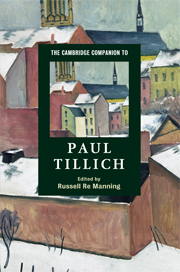Book contents
- Frontmatter
- Part I Standing within the theological circle
- Part II Theology of culture
- Part III Tillich in dialogue
- 14 Tillich in dialogue with natural science
- 15 Tillich in dialogue with psychology
- 16 Tillich in dialogue with Japanese Buddhism: a paradigmatic illustration of his approach to inter-religious conversation
- 17 Tillich and feminism
- 18 Tillich and the postmodern
- Bibliography
- Index
14 - Tillich in dialogue with natural science
from Part III - Tillich in dialogue
Published online by Cambridge University Press: 28 May 2009
- Frontmatter
- Part I Standing within the theological circle
- Part II Theology of culture
- Part III Tillich in dialogue
- 14 Tillich in dialogue with natural science
- 15 Tillich in dialogue with psychology
- 16 Tillich in dialogue with Japanese Buddhism: a paradigmatic illustration of his approach to inter-religious conversation
- 17 Tillich and feminism
- 18 Tillich and the postmodern
- Bibliography
- Index
Summary
Paul Tillich's theological method of correlation, along with much of the actual content of his theology, is indicative of his immersion in the modern cultural 'situation' in which reason is shaped principally by natural science. Tillich's way of doing theology is hardly conceivable apart from his belonging to the age of science and its requirement that enlightened theologians give their discipline not only religious relevance but also intellectual stature. If it expects to be credible in the contemporary period of history, theology must be fully aware of science and the respect scientific understanding commands. Above all, however, it must avoid ever giving the impression of standing in a competitive relationship with science, nor should it approve or reject any set of scientific ideas for purely theological reasons. 'The distinction between the truth of faith and the truth of science leads to a warning, directed to the theologians, not to use recent scientific discoveries to confirmthe truth of faith' (DF, 85).
- Type
- Chapter
- Information
- The Cambridge Companion to Paul Tillich , pp. 223 - 237Publisher: Cambridge University PressPrint publication year: 2009
- 1
- Cited by

